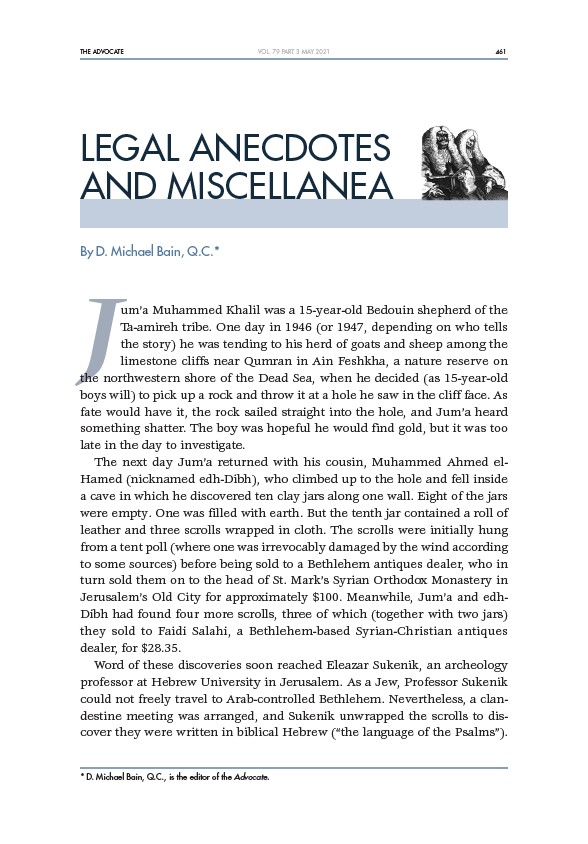
THE ADVOCATE 461
VOL. 79 PART 3 MAY 2021
LEGAL ANECDOTES
AND MISCELLANEA
By D. Michael Bain, Q.C.*
Jum’a Muhammed Khalil was a 15-year-old Bedouin shepherd of the
Ta-amireh tribe. One day in 1946 (or 1947, depending on who tells
the story) he was tending to his herd of goats and sheep among the
limestone cliffs near Qumran in Ain Feshkha, a nature reserve on
the northwestern shore of the Dead Sea, when he decided (as 15-year-old
boys will) to pick up a rock and throw it at a hole he saw in the cliff face. As
fate would have it, the rock sailed straight into the hole, and Jum’a heard
something shatter. The boy was hopeful he would find gold, but it was too
late in the day to investigate.
The next day Jum’a returned with his cousin, Muhammed Ahmed el-
Hamed (nicknamed edh-Dibh), who climbed up to the hole and fell inside
a cave in which he discovered ten clay jars along one wall. Eight of the jars
were empty. One was filled with earth. But the tenth jar contained a roll of
leather and three scrolls wrapped in cloth. The scrolls were initially hung
from a tent poll (where one was irrevocably damaged by the wind according
to some sources) before being sold to a Bethlehem antiques dealer, who in
turn sold them on to the head of St. Mark’s Syrian Orthodox Monastery in
Jerusalem’s Old City for approximately $100. Meanwhile, Jum’a and edh-
Dibh had found four more scrolls, three of which (together with two jars)
they sold to Faidi Salahi, a Bethlehem-based Syrian-Christian antiques
dealer, for $28.35.
Word of these discoveries soon reached Eleazar Sukenik, an archeology
professor at Hebrew University in Jerusalem. As a Jew, Professor Sukenik
could not freely travel to Arab-controlled Bethlehem. Nevertheless, a clandestine
meeting was arranged, and Sukenik unwrapped the scrolls to discover
they were written in biblical Hebrew (“the language of the Psalms”).
* D. Michael Bain, Q.C., is the editor of the Advocate.